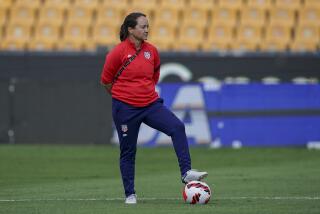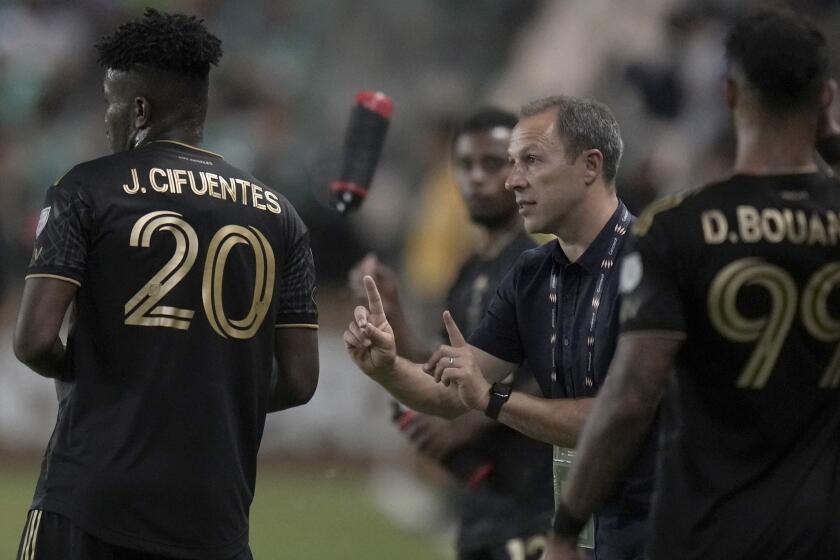WISE GUY GETS SMART : Lax Attitude Toward Schoolwork as a Freshman Cost CSUN Midfielder Steve Linhart Two Seasons of Eligibility, but the Lesson Has Been Learned; He’s Back and Ranks Among Team Scoring Leaders
The ball rolled into the net and touched off the kind of celebration usually reserved for World Cup goals. Steve Linhart exhaled, and with that one breath, his emotional baggage seemingly was borne away.
Linhart had just scored his first goal before the Cal State Northridge soccer faithful in three years. He was back after a two-year sentence.
His crime? A casual attitude toward school that the junior midfielder never figured would cost him the thing he loves most.
Soccer had been part of his life since he was a tot, chasing the ball with other 5-year-olds like bees after pollen.
By the time he had reached Thousand Oaks High, Linhart could pass and shoot with his feet and his head. He was small, though, and at 5-foot-6, 110 pounds took his share of hits.
As a junior, he was the co-leader in the Marmonte League in assists with 23. In his senior year, 1986, he scored a school-record 20 goals and added 13 assists. Despite his exploits, Linhart, who had grown to only 5-8 and 140 pounds, was not heavily recruited.
“I played in the shadows of Eric Wynalda (Westlake High standout who wound up on the national team ),” Linhart said. “He stole all the headlines. I never really turned any heads. I was never a flashy player. I still don’t think I am.”
But Linhart’s skills were immediately evident to CSUN Coach Marwan Ass’ad who signed him to a scholarship.
“Marwan sold me from the start,” Linhart said. “I learned so much about the game from him. I never realized there was so much more than I knew.”
Not that Linhart needed more convincing, but that’s what national power UCLA provided in its season-opening exhibition match against the Matadors.
“I played the worst game of my life,” said Linhart, the only freshman who started. “I had no idea what college soccer was about.”
After stints in the next two matches, he sat on the bench for nine consecutive matches. “I was so frustrated,” Linhart said. “I knew I couldn’t quit, but I thought about it.”
An injury to a teammate gave Linhart another chance to play, although his appearances were limited throughout the rest of the season.
“But I learned a lot,” Linhart said. “Marwan had a specific system, a way that all 11 players look at something and try to accomplish it. No coach I’d ever talked to showed it to me in that light. He showed us films of the World Cup and the Italian teams. He’d point out the way they played and he’d show us the way.”
Six weeks into spring drills, Linhart said, “The light really clicked for me.”.
“It hit me and I put all the things into my game, not to say that I didn’t have more to learn.”
Although the light was shining on the soccer field, it had been fading for a long time in the classroom.
“I am a smart guy,” said Linhart, who scored a 1,260 (out of a possible 1,600) on the Scholastic Aptitude Test. “But I’ve had this lazy streak since sixth grade. I coasted through high school. My study habits were awful.”
Like many college freshmen, Linhart reveled in his new-found freedom.
“I had a blast,” he said. “I lived it up. I loved being out on my own and not having anybody to worry about when I’d be home and what I was doing.”
The end result: a 1.4 grade-point average in his first semester.
“I realized I messed up,” Linhart said. “I tried harder (in the) second semester and I thought I would be able to pull it out, but it wasn’t enough.”
Linhart managed a 2.5 in the second semester, but his cumulative, 1.9, was short of the 2.0 required to compete in intercollegiate athletics.
“It was probably one of the bigger disappointments of my life,” Linhart said. “The second semester I was studying the best I knew how, but when I look back now I didn’t know how to study. I had a habit of getting behind. It almost exclusively came down to finals where I had to cram and do really well.”
That was not the case in the fall of 1988 when Linhart sat out the season and improved his grades. The following spring, he rejoined the team for practice.
But that proved to be a costly mistake. Neither Linhart nor Ass’ad realized that his academic ineligibility, under university rules, excluded him from practices for the entire school year. Consequently, he was declared ineligible for the ’89 season.
“I don’t blame anybody else,” Linhart said. “The original problem was my fault. But it was really, really disappointing. We had a great team. We had won the CCAA (California Collegiate Athletic Assn.) five years in a row. We had been in the national championships two years in a row and I really felt we had a real chance at (winning) the national championship.”
After enduring another year on the sidelines, he geared up for spring drills--he was allowed to take part this time--and participation on a club team.
“The weight had been lifted,” Linhart said. “I knew I wasn’t going to mess up again. Being back with the team felt awesome. My skills never really left. I was a little surprised.”
In a club match against players from Cal State Fullerton, Linhart put it all together.
“They were a really big team and because of the sheer size of them I played aggressive the whole game,” he said. “For the first time, I felt intimidated, but when I got the ball they backed off. They knew I could go by them. I didn’t know I had it in me until then. I don’t know that I’ve had that since then.”
That’s because since then Linhart has been playing hurt. He is still rehabilitating his left knee while playing with a broken bone in his right hand.
Linhart underwent knee surgery June 30 for a bypartite patella, a congenital condition in which his kneecap was growing in two pieces. He feared that he would miss the start of his first season in two years and CSUN’s Division I debut, but a rigid conditioning program enabled him to play the first five games in a reserve role.
“The upper leg muscles atrophied so badly after surgery the doctor wasn’t worried about me hurting my knee as much as injuring something else,” said Linhart, who was able to start by the third week of the season.
Then, he injured his right hand in a match against San Diego State. He played two days later against the University of San Diego, took another spill and landed on it again. X-rays revealed a broken bone. A cast was required that extends almost to his elbow.
“He couldn’t get a fourth strike,” teammate Scott Hunter said. “He deserves success more than anybody. It is time for him.”
The injuries and the layoff notwithstanding, Linhart has made it his time for the 5-5-3 Matadors. In just seven starts, he is third on the team in scoring with four goals and one assist after Tuesday night’s 3-0 victory over San Luis Obispo.
“The layoff didn’t hurt him mentally or technically,” Ass’ad said.
“Technically, once you are skillful, once you have the touch, it is hard to leave you because you worked so hard to get it. In the spring Steve practiced with us and showed so much anticipation. So much mental edge over the other players.
“The layoff did hurt him physically because he’s a little player, though he has a lot of guts. I knew he would be this good. I always knew if he was stronger physically he would be shown as an All-American.”
No wonder Linhart was named to the Aces Soccer Classic all-tournament team despite being held scoreless in the event two weeks ago in Evansville, Ind.
Quick thinking is the key, according to Linhart.
“I always have an idea,” he said. “When I get the ball I know what I want to do.”
Linhart remains not nearly as certain in a classroom setting. Not only is he unsure of his major--he might switch from English to business--he has no idea what he will do after college.
One option, although Linhart concedes that the odds are long, is a career as a professional soccer player. But it is not something on which he dwells.
Linhart’s course load demands his attention: His GPA is a precarious 2.1.
But Linhart has the motivation--the result of two years on the sideline--not to let it slip.
“I don’t know what I’d do,” he said, “if I couldn’t keep playing soccer.”






